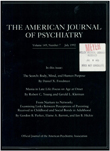Plasma norepinephrine in chronic schizophrenia
Abstract
Several lines of evidence indicate altered noradrenergic function in schizophrenia. The authors examined resting, standing, and change (standing minus resting) in plasma norepinephrine levels in 14 drug- free patients with chronic schizophrenia or schizoaffective disorder and in 33 age- and sex-matched healthy volunteers. Schizophrenic patients had significantly higher resting and standing plasma norepinephrine levels and significantly greater change. Resting and standing levels were significantly related to positive and negative symptoms. There was a significant positive correlation between resting plasma and CSF norepinephrine levels and a significant negative correlation between CSF homovanillic acid and resting, standing, and change in plasma norepinephrine levels.
Access content
To read the fulltext, please use one of the options below to sign in or purchase access.- Personal login
- Institutional Login
- Sign in via OpenAthens
- Register for access
-
Please login/register if you wish to pair your device and check access availability.
Not a subscriber?
PsychiatryOnline subscription options offer access to the DSM-5 library, books, journals, CME, and patient resources. This all-in-one virtual library provides psychiatrists and mental health professionals with key resources for diagnosis, treatment, research, and professional development.
Need more help? PsychiatryOnline Customer Service may be reached by emailing [email protected] or by calling 800-368-5777 (in the U.S.) or 703-907-7322 (outside the U.S.).



